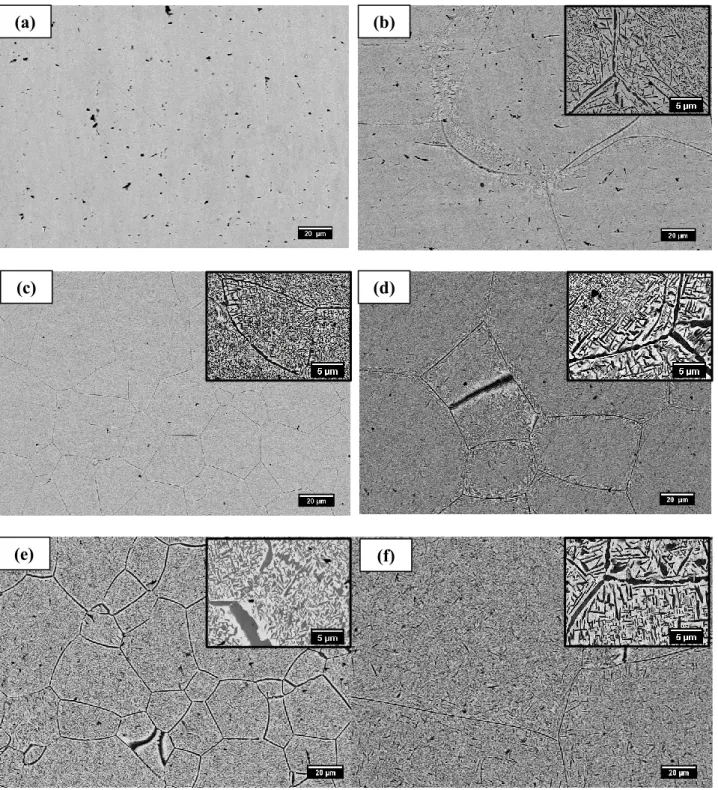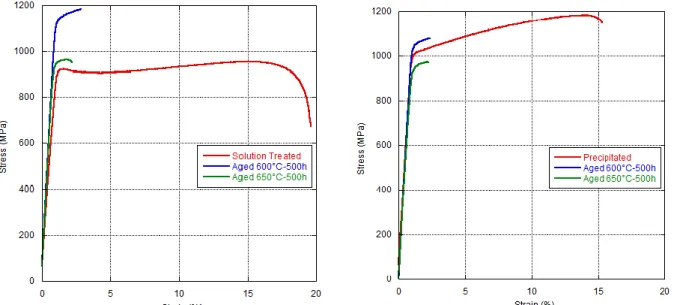OATAO is an open access repository that collects the work of Toulouse researchers and makes it freely available over the web where possible
Any correspondence concerning this service should be sent
to the repository administrator: tech-oatao@listes-diff.inp-toulouse.fr
This is an author’s version published in: http://oatao.univ-toulouse.fr/24476
To cite this version:
Vigié, Héloïse and Soula, Aurélie and Viguier, Bernard Aging of the β21S
Titanium Alloy. (2016) Solid State Phenomena, 258. 550-553. ISSN 1662-9779
Aging of the
21S Titanium Alloy
Héloïse Vigié
1,2,a, Aurélie Soula
2,band Bernard Viguier
1,c1Institut Carnot CIRIMAT, ENSIACET-INPT Université de Toulouse, 4 allée Emile Monso –
BP74233 – 31030 Toulouse Cedex 4, France
2 Safran Aircelle, rue des Jeunes Bois – CS 80112, 78772 Magny-Les-Hameaux, France aheloise.vigie@ensiacet.fr, baurelie.soula@aircelle.fr, cbernard.viguier@ensiacet.fr
Keywords: Ti-21S alloy, aging, mechanical properties, microstructure, beta titanium alloy
Abstract. Ti-21S is a -metastable titanium alloy, currently used in industries such as aeronautics,
because of its cold formability, good mechanical properties at elevated temperature, low density and its strong resistance to oxidation. This alloy is hardened by an -phase precipitation in the -matrix. The purpose of the present research is to establish the effect of aging on the microstructure and mechanical properties of Ti-21S. Different thermal aging tests have been carried out at 600°C and at 650°C for 500 hours in laboratory air. The evolution of the microstructure has been reported after each thermal treatment and associated with room temperature tensile tests results.
Introduction
Ti-21S is a recent alloy developed by Timet USA in 1990 [1]. It was developed to be used as a matrix in composite materials and is currently used in aeronautics to produce covers, caps and nozzles [2]. It has good properties at high temperatures and a better creep resistance than Ti6Al4V, the most commonly used Ti alloy [3]. Highly resistant to corrosion, Ti-21S is often used in the presence of hot fluids.
Aging treatments on Ti-21S sheets were performed at 600°C and 650°C for 500h in laboratory air, starting with i) a solution and ii) precipitation treatments. The evolution of the microstructure and the mechanical properties were then studied using scanning electron microscopy (SEM) observations and tensile tests at room temperature.
Material and experimental procedure
The 1.0 mm thick Ti-21S sheets used were supplied in solution-state. The nominal composition of this alloy is: Ti-15Mo-3Al-2.7Nb-0.3Si (in wt%). Specimens of 50x50 mm² and tensile specimens were laser machined. A first batch of specimens corresponds to this as-received solution-state. A second batch underwent thermal treatments resulting in an -precipitated state. In these thermal states, aging treatments were performed in laboratory air at 600 ° C and 650 ° C for 500h. The heating rate was set to 6 – 7 °C/min and the specimens were air-cooled at the end of treatment. For metallographic observations, the samples were mechanically ground on SiC paper down to grade 2400 and then polished using OPS solution to obtain a mirror surface. Each sample was then examined by SEM (using a LEO 435VP - EDS INCA Operating at 15 kV). Higher magnification observations necessitated the use of a JEOL field emission SEM JSM-7800F Prime, from the UMS Castaing Centre, operating at 5 kV. All analyses were carried out using the backscattered electrons mode. An MTS 810 servo-hydraulic machine was used for tensile tests at an imposed displacement rate of 0.013 mm/s. The gage length of specimens was 30 mm, the cross section was (7 x 1) mm² and the elongation was measured by extensometry. All tensile tests were performed at room temperature.
Effect of heat treatment on the microstructure
SEM observations of the two types of specimens are reported in Fig.1 for the initial and aged states. As expected, the initial state of the solution-treated alloy (Fig.1a) shows a single-phased material, and the precipitation-treated alloy shows precipitates at the grain boundaries and within the grains (Fig.1b). The size of the precipitates is heterogeneous, exhibiting bands of coarse precipitates along the grain boundaries and a fine and homogenous distribution in the centre of the grains.
Fig 1: Microstructure observations of Ti-21S for the two types of specimen used: as-received solution treatment (left column) and precipitation treatment (right column). The images shown correspond to the initial state (a,b), after thermal aging for 500 h at 600°C (c,d) and 650°C (e,f).
(a) (c) (e) (b) (d) (f)
Aging treatments from the solution-treated alloy lead to an -phase precipitation at the grain boundaries and within the grains, as shown in Fig.1c for the thermal treatment at 600°C and Fig.1e for the thermal aging at 650°C. The size of the precipitates is homogeneous showing nearly the same size in the vicinity of the grain boundaries and within the grains. The size of the precipitates increases as the temperature of thermal treatment increases [4]. For the precipitated state, precipitates grow after aging treatment, and the morphology and precipitation density is more homogeneous, Fig.1 (d and f). The precipitation of the phase is thinner after aging from the solution-treated state than after aging from the precipitated microstructure. The grain size of both states was also compared. A micrograph examination indicates that the grain size is higher in the precipitated state in comparison to the solution treatment, which is certainly due to previous steps in the thermal processing treatment. The grain size does not seem to vary during further aging treatment in both the solution and precipitated states.
Tensile behaviour of the alloy Ti-21S
Tensile tests were performed up to rupture in the various metallurgical states exposed above with constant displacement rate corresponding to about 4.4 10-4 s-1. The resulting true-stress-true-strain tensile curves are presented in Fig.2. For the initial state of the solution treatment, the material shows a yield behaviour with 0.2% offset plastic strain flow stress 0.2 = 922 MPa. The yield is followed by a moderate hardening after a flow plateau and the rupture occurs with significant necking for a total strain of rup = 19.6 %. The corresponding curve for the precipitated state exhibits a different behaviour, with 0.2 = 1012 MPa, no yield and a constant strain hardening rate. The rupture occurs quite suddenly for a total strain of rup = 15.5 %. These tensile behaviours agree quite well with the microstructural observations: the lower flow stress and very weak strain hardening is associated to a single phased bcc alloy for the solution treated microstructure and the higher stress and strong strain hardening rate corresponds to precipitate hardened alloy for the precipitated state.
Fig 2: Tensile true-stress-true-strain curves for the solution (left plot) and the precipitated (right plot) microstructures.
In the same way, the results of tensile tests on specimens after thermal aging treatments at 600°C and 650°C for 500h can be compared with the results obtained from the specimen in initial state. The first observation concerns the drastic decrease in the fracture elongation from about 15 – 20 % for the initial states down to less than 3 % after aging. Thermal aging was carried out in laboratory air. The metal thus reacts with oxygen as evidenced on the one hand by the formation of an outer
oxide layer and on the other hand by the absorption of oxygen underneath the surface leading to microstructural evolution of the alloy. Such reactivity is commonly observed to have a strong detrimental effect on Ti alloy ductility [5, 6]. For the solution state microstructure, flow stress increases after thermal aging treatment. Measurements found 0.2 = 1140 MPa for the thermal treatment at 600°C and 950 MPa at 650°C. Starting from the single-phased microstructure in the initial solution treatment, aging at 600°C creates a homogeneous and fine precipitation resulting in a strong increase of flow stress. By contrast, aging at 650°C results in a coarser precipitation state that slightly hardens the alloy in comparison to the solution state. For the precipitated microstructure, thermal aging at 600°C leads to an increase of 0.2 up to 1045 MPa whereas this value decreases to 949 MPa for the thermal treatment at 650°C. After aging at 600°C, the slight microstructure evolution in the centre of the sheet induces a small increase of the flow stress by 30 MPa. The decrease in flow stress after aging at 650°C is related to a coarsening of the precipitates.
These mechanical test results are congruent with the microstructure evolution in -21S sheet. They highlight the effect of oxygen, mainly on the ductility of the alloy. The comparison of the aging treatment performed at 600°C for 500h shows different microstructures and mechanical resistances depending on the initial state. By contrast, aging at 650°C leads to comparable states for the two initial microstructures.
Conclusion
In this study, thermal aging treatments at 600°C and 650°C for 500 hours were conducted on two types of microstructures of the alloy -21S, solution-treated and precipitated microstructures. The tensile behaviour of the material was related to the microstructure evolution. A fine and homogeneous precipitation of -phase resulted in an increase of mechanical resistance, whereas aging oxygen absorption during aging treatment performed in air reduces the ductility of the alloy drastically. The initial microstructure has a dominant role in the evolution of material properties with respect to aging at 600°C unlike aging at 650°C. Another factor to take into account at this temperature is the diffusion of oxygen in the material. Further investigations should be conducted to explain the effect of oxygen on both microstructures and mechanical behaviour.
References
[1] Bania, P.J. and W.M. Parris, Oxidation resistant titanium-base alloy, U.S. Patent, Editor. (1990.
[2] Boyer, R.R., Materials Sciences and Engineering A. 213, (1996), p. 103-114.
[3] Weiss, I. and S.L. Semiatin, Materials Science and Engineering: A. 243 (1), (1998), p. 46-65.
[4] Mahoney, M.W., P.L. Martin, and D. Hardwick, Titanium'92: Science and technology. (1993), p. 161-168.
[5] Parris, W.M. and P.J. Bania, Titanium'92: Science and technology. (1993), p. 153-160. [6] Sansoz, F., M. Almesallmy, and H. Ghonem, Metallurgical and Materials Transactions A.

